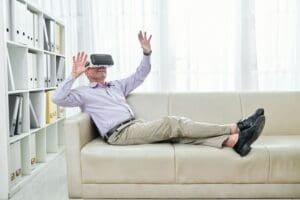
Revolutionizing Exposure Therapy
Virtual Reality (VR) therapy represents a groundbreaking advancement in mental health treatment, particularly in the realm of exposure therapy. Traditional exposure therapy has long been a cornerstone in treating various anxiety disorders and phobias. It typically involves either asking clients to vividly imagine anxiety-inducing scenarios or physically exposing them to feared stimuli in real-world settings (known as in-vivo exposure therapy).
While effective, traditional methods can present challenges:
- Some clients struggle
 with visualization, limiting the effectiveness of imaginal exposure.
with visualization, limiting the effectiveness of imaginal exposure. - In-vivo exposures can be costly, impractical, or even impossible to arrange in certain cases.
- Real-world exposures may compromise client privacy and confidentiality.
This is where Virtual Reality Therapy shines. It offers a powerful solution that addresses these limitations while enhancing the overall therapeutic experience.
Important Note
Virtual Reality Therapy is an in-office treatment modality. It cannot be conducted over the internet or in the metaverse. This ensures that you receive the full benefits of the therapy under the direct guidance and support of Dr. Estupinian.
The VR Therapy Advantage
- Enhanced Immersion: VR provides a level of immersion that surpasses traditional imagination-based techniques, making it ideal for clients who struggle with visualization.
- Safe and Controlled Environment: Clients can confront their fears in a secure, virtual space under the careful guidance of Dr. Ginny Estupinian PhD.
- Customizable Experiences: Dr. Estupinian can tailor the virtual environment to match each client’s specific needs and fears, ensuring a personalized treatment approach.
- Cost-Effective: VR eliminates the need for expensive or impractical real-world exposures (e.g., airplane flights for treating fear of flying).
- Repeatable Scenarios: Dr. Estupinian can easily repeat or modify exposures as needed, allowing for gradual and systematic desensitization.
- Privacy and Confidentiality: VR exposures can be conducted entirely within Dr. Estupinian’s office, maintaining client privacy.
- Precise Control: Dr. Estupinian has complete control over the virtual environment, allowing her to adjust the intensity and specific aspects of the exposure in real time.
- Client Satisfaction: Research indicates that many patients find VR-based therapy more acceptable and satisfying compared to traditional approaches.
Applications of Virtual Reality Therapy
The versatility of VR therapy makes it an excellent tool for addressing a wide range of mental health concerns:
- Anxiety Disorders and Phobias:
- Social anxiety

- Agoraphobia
- Claustrophobia
- Fear of flying
- Fear of public speaking
- Driving phobia
- Social anxiety
- Post-Traumatic Stress Disorder (PTSD):
- Combat-related PTSD
- Trauma from natural disasters or accidents
- Depression:
- Skills training for managing
 depression
depression - Addressing teenage depression
- Skills training for managing
- Mindfulness and Relaxation:
- Mindfulness skills training
- Meditation practice
- Relaxation techniques before, during, and after medical procedures
- Attention and Focus:
- Attention skills training

- Practicing focus without distractions
- Attention skills training
- General Well-being:
- Enhancing the overall sense of well-being
- Stress reduction
Dr. Ginny Estupinian's Virtual Reality Therapy Program
Dr. Ginny Estupinian PhD offers a state-of-the-art Virtual Reality Therapy program designed to provide the most effective and comfortable experience for her clients.
Immersive Environments
Dr. Estupinian’s VR therapy sessions offer a diverse range of authentic virtual environments where clients can:
- Interact with virtual people and places

- Face their fears in a controlled setting
- Practice conversations and social interactions
- Visit remote or inaccessible locations
- Relax in tranquil, calming settings
These immersive environments are highly customizable, allowing for a “choose your own adventure” style of therapy. For example:
- Driving Phobia Program: Clients can experience driving on various types of roads, bridges, and highways under different weather conditions.
- Public Speaking Program: Clients can practice giving presentations in front of virtual audiences, with Dr. Estupinian controlling factors such as audience size, receptiveness, and even clothing.
- Agoraphobia Program: Clients can gradually expose themselves to crowded places, public transit, open spaces, and other challenging environments.
Cutting-Edge Equipment
Dr. Estupinian utilizes the latest medical-grade wireless VR systems to ensure your therapy sessions are:
- Comfortable
- Safe
- Private
- Highly effective
The VR Therapy Experience with Dr. Ginny Estupinian PhD, ABPP
During a VR therapy session, you’ll work closely with Dr. Estupinian to:
- Identify specific fears or anxiety triggers
- Develop a personalized treatment plan
- Gradually expose yourself to anxiety-inducing scenarios in the virtual environment
- Learn and practice coping strategies in real-time
- Process your experiences and track your progress
Dr. Estupinian will have complete control over the virtual environment, allowing her to:
- Adjust the intensity of exposures
- Introduce or remove specific elements
- Repeat scenarios as needed
- Ensure the pacing matches your individual needs and comfort level
For example, if you’re working on overcoming a fear of flying but aren’t ready to experience turbulence, Dr. Estupinian can guarantee a smooth virtual flight. As you progress, she can gradually introduce more challenging elements to build your confidence and resilience.
Is Virtual Reality Therapy Right for You?
Virtual Reality Therapy has shown promising results for many individuals struggling with anxiety, phobias, PTSD, and other mental health concerns. If you’re interested in exploring this innovative treatment option, we encourage you to reach out to Dr. Estupinian’s office.
Dr. Estupinian will be happy to:
- Provide more detailed information about VR therapy
- Assess whether it’s a suitable option for your specific concerns
- Answer any questions you may have about the process
- Help you get started on your journey to better mental health
Find out more
Don’t let fear or anxiety hold you back any longer. Experience the power of Virtual Reality Therapy with Dr. Ginny Estupinian PhD and take the first step towards a more confident, fulfilling life.
Call today to schedule a consultation and learn how VR therapy can help you overcome your challenges in a safe, controlled, and effective manner.
Call 844-802-6512
or
Click here to Book Online
Contact Us
Our Staff is ready to answer all your virtual reality questions and book your appointment.
Explore Virtual Reality Research Articles
DIFEDE, J. , CUKOR, J. , PATT, I. , GIOSAN, C. and HOFFMAN, H. (2006), The Application of Virtual Reality to the Treatment of PTSD Following the WTC Attack. Annals of the New York Academy of Sciences, 1071: 500-501. doi:10.1196/annals.1364.052
Falconer, C., Rovira, A., King, J., Gilbert, P., Antley, A., Fearon, P., . . . Brewin, C. (2016). Embodying self-compassion within virtual reality and its effects on patients with depression. BJPsych Open, 2(1), 74-80. doi:10.1192/bjpo.bp.115.002147
Fodor L.A., Carmen D. Coteț C.D., Cuijpers, P.,Szamoskozi, S., Ioana, D.D., Cristea, A. (2018) The effectiveness of virtual reality based interventions for symptoms of anxiety and depression: A meta-analysis. Scientific Reports volume 8, Article number: 10323
Gonçalves R, Pedrozo AL, Coutinho ESF, Figueira I, Ventura P (2012) Efficacy of Virtual Reality Exposure Therapy in the Treatment of PTSD: A Systematic Review. PLoS ONE 7(12): e48469. https://doi.org/10.1371/journal.pone.0048469
Jones T, Moore T, Choo J (2016) The Impact of Virtual Reality on Chronic Pain. PLoS ONE 11(12): e0167523. https://doi.org/10.1371/journal.pone.0167523
McSherry, T., Atterbury, M., Gartner, S., Helmold, E., Mazzacano, D., Schulman, C., Randomized, Crossover Study of Immersive Virtual Reality to Decrease Opioid Use During Painful Wound Care Procedures in Adults, Journal of Burn Care & Research, Volume 39, Issue 2, March/April 2018, Pages 278–285, https://doi.org/10.1097/BCR.0000000000000589
Maples-Keller, J. L., Bunnell, B. E., Kim, S. J., & Rothbaum, B. O. (2017). The Use of Virtual Reality Technology in the Treatment of Anxiety and Other Psychiatric Disorders. Harvard review of psychiatry, 25(3), 103–113. doi:10.1097/HRP.0000000000000138
Rizzo, A., Cukor, J., Gerardi, M. et al. J Contemp Psychother (2015) 45: 255. https://doi.org/10.1007/s10879-015-9306-3
Rothbaum, B. O., Hodges, L., Smith, S., Lee, J. H., & Price, L. (2000). A controlled study of virtual reality exposure therapy for the fear of flying. Journal of Consulting and Clinical Psychology, 68(6), 1020-1026.
Shah, Lubna Bte Iskhandar et al.Efficacy of the Virtual Reality-Based Stress Management Program on Stress-Related Variables in People With Mood Disorders: The Feasibility Study. Archives of Psychiatric Nursing, Volume 29, Issue 1, 6 – 13
Zeng, N., Pope, Z., Lee, J., & Gao, Z. (2018). Virtual Reality Exercise for Anxiety and Depression: A Preliminary Review of Current Research in an Emerging Field. Journal of Clinical Medicine, 7(3), 42. MDPI AG. Retrieved from http://dx.doi.org/10.3390/jcm7030042
 with visualization, limiting the effectiveness of imaginal exposure.
with visualization, limiting the effectiveness of imaginal exposure.
 depression
depression
